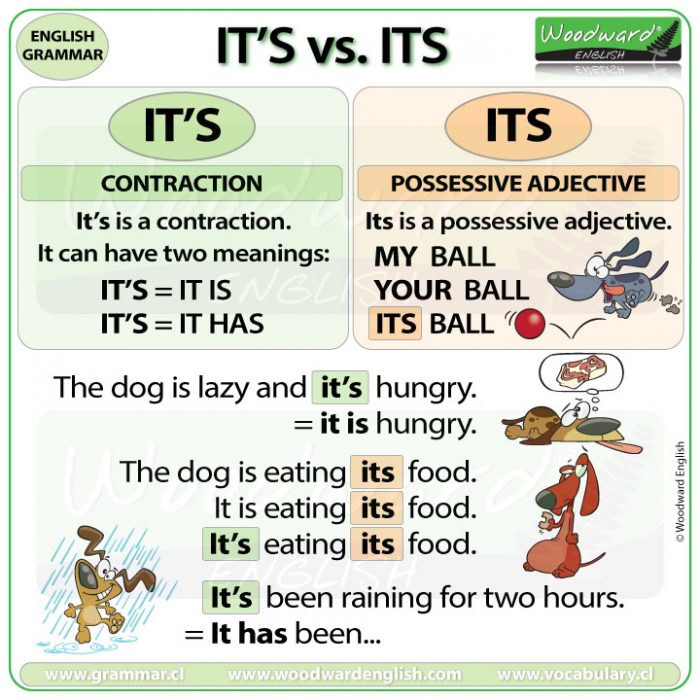What is the difference between IT’S and ITS?
IT’S has an apostrophe and ITS doesn’t have an apostrophe.
What is the difference?
Basic Explanation
Its, with NO apostrophe, is a possessive adjective.
Examples of possessive adjectives are MY, YOUR, HIS, HER and ITS:
My ball, Your ball, Its ball.
- The dog is playing with its ball.
We use ITS… when we are talking about an animal or thing.
It’s, with an apostrophe, is a contraction of it is or it has.
- The dog is lazy and it’s hungry. (It’s here means It is … it is hungry)
- It’s been raining for two hours. (It’s here mean IT HAS… It has been raining for two hours)
Now look at this example:
- The dog is eating its food. (Its is a possessive adjective)
- The dog is not eating my food or your food. The dog is eating its food.
Instead of saying THE DOG, we can replace the subject THE DOG with the pronoun IT.
- The dog is eating its food =
- It is eating its food.
Now we can make a contraction of IT + IS = IT’S
- It’s eating its food.
This sentence is an example of Its and It’s in the same sentence:
Can you see the difference?
The first IT’S is a contraction of IT IS … and the second ITS is a possessive adjective.
MORE DETAILS…
Its = a possessive adjective
Its is a possessive adjective.
A possessive adjective is used before a noun to show possession.
Its belongs to the pronoun it.
Remember IT is used for animals and things.
Its + noun
- The dog has a ball. Its ball is red.
We want to show that the ball is a possession of the dog. We use Its because a dog is an animal.
- MY is the possessive adjective of I. – My ball is green.
- YOUR is the possessive adjective of YOU. – Your ball is blue.
- ITS is the possessive adjective of IT. – Its ball is red.
It’s = It is
It’s is normally a contraction of It is.
- It’s hot today. =
- It is hot today.
More examples of It’s = It is:
- It’s ready.
- It’s on the table.
- It’s a red car.
It’s = It has
It’s can also be a contraction of It has.
- It’s been raining for three hours. =
- It has been raining for three hours.
More examples of It’s = It has:
- It’s finished early.
- It’s taken a long time.
- It’s been a productive meeting.
Notice that after It has, we use a past participle (finished, taken, been).
We will learn more about past participles and the perfect tense in another lesson.
How do we know if IT’S means IT IS or IT HAS?
It depends on the word that comes next.
It’s = It is … is normally followed by an adjective.
- It’s cold today. (cold is an adjective)
- It’s small.
It’s = It is … can be followed by a verb ending in -ING.
- It’s raining right now.
- It’s going to be great.
It’s = It is … can also be followed by a noun.
Before the noun there is usually an article (a, an, the)
- It’s an insect. (insect is a noun)
- It’s a beautiful dress. (There can be an adjective before the noun)
It’s = It has … is normally followed by a past participle.
- It’s been ready for three hours. (= It has been…)
- It’s taken a long time. (= It has taken)
More examples of IT’S vs. ITS
Can you see the different uses?
- Chile is famous for its wine … and its earthquakes.
- Take an umbrella because it’s going to rain.
- The cat is licking its paw.
- It’s been a long day.
How can I remember the difference?
Replace the word with IT IS.
If it sounds correct then IT’S is correct.
If it doesn’t sound correct, then you need to use ITS.
It’s cold in Alaska.
It is cold in Alaska. (CORRECT)
The dog hurt it’s feet.
The dog hurt it is feet. (INCORRECT)
The dog hurt its feet. (CORRECT)










0 Comments